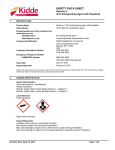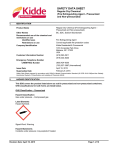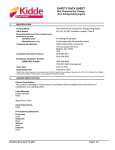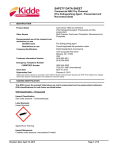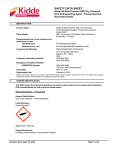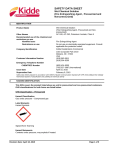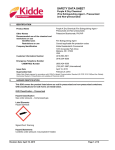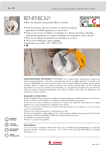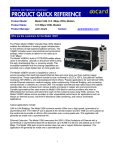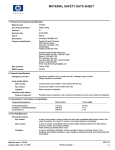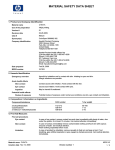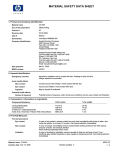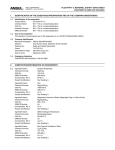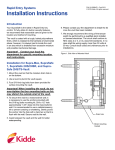Download Kidde 466180 Data Sheet
Transcript
SAFETY DATA SHEET Carbon Dioxide (Fire Extinguishing Agent and Expellant) 1. IDENTIFICATION Product Name Other Names Recommended use of the chemical and restrictions on use Identified uses Restrictions on use Company Identification Customer Information Number Emergency Telephone Number CHEMTREC Number Issue Date Supersedes Date Carbon Dioxide (Fire Extinguishing Agent and Expellant) CO2 Fire Extinguishing Agent and Expellant Consult applicable fire protection codes Kidde Residential & Commercial 1016 Corporate Park Drive Mebane, NC 27302 USA (919) 563-5911 (919) 304-8200 (800) 424-9300 (703) 527-3887 (International) April 10, 2015 February 9, 2015 Safety Data Sheet prepared in accordance with OSHA’s Hazard Communication Standard (29 CFR 1910.1200) and the Globally Harmonized System of Classification and Labelling of Chemicals (GHS) 2. HAZARD IDENTIFICATION Hazard Classification Gas under pressure – liquefied gas Simple Asphyxiant Label Elements Hazard Symbols Signal Word: Warning Hazard Statements Contents under pressure; may explode if heated. May displace oxygen and cause rapid suffocation. Precautionary Statements Prevention Do not enter confined space unless adequately ventilated. In case of inadequate ventilation wear respiratory protection. Revision Date: April 10, 2015 Page 1 of 7 SAFETY DATA SHEET Carbon Dioxide (Fire Extinguishing Agent and Expellant) 2. HAZARD IDENTIFICATION Response None Storage Keep container tightly closed. Protect from sunlight and store in well-ventilated place. Disposal None Other Hazards Direct contact with the cold gas or liquid can cause freezing of exposed tissues. Avoid direct inhalation of undiluted gas. Can cause suffocation by reducing oxygen available for breathing. Breathing very high concentrations can cause dizziness, shortness of breath, unconsciousness or asphyxiation. Specific Concentration Limits The values listed below represent the percentages of ingredients of unknown toxicity. Acute oral toxicity 0% Acute dermal toxicity 0% Acute inhalation toxicity 0% Acute aquatic toxicity 100% 3. COMPOSITION/INFORMATION ON INGREDIENTS Synonyms: CO2 This product is a substance. Component Carbon Dioxide 4. CAS Number 124-38-9 Concentration >99.8% FIRST- AID MEASURES Description of necessary first-aid measures Eyes Immediately flood the eye with plenty of water for at least 15 minutes, holding the eye open. Obtain medical attention if soreness or redness persists. Skin Gently warm affected areas. Obtain medical attention if frostbite or blistering occurs or redness persists. Ingestion Ingestion is not considered a potential route of exposure. Inhalation Remove from exposure. If there is difficulty in breathing, give oxygen. Obtain medical attention immediately. Most important symptoms/effects, acute and delayed Aside from the information found under Description of necessary first aid measures (above) and Indication of immediate medical attention and special treatment needed, no additional symptoms and effects are anticipated. Revision Date: April 10, 2015 Page 2 of 7 SAFETY DATA SHEET Carbon Dioxide (Fire Extinguishing Agent and Expellant) 4. FIRST- AID MEASURES Indication of immediate medical attention and special treatment needed Notes to Physicians In case of frostbite, place the frostbitten part in warm water. If warm water is not available or impractical to use, wrap the affected parts gently in blankets. DO NOT USE HOT WATER. 5. FIRE - FIGHTING MEASURES Suitable Extinguishing Media Carbon Dioxide is used as an extinguishing agent and therefore is not a problem when trying to control a blaze. Use extinguishing agent appropriate to other materials involved. Keep containers and surroundings cool with water spray as containers may rupture or burst in the heat of a fire. Specific hazards arising from the chemical Containers may explode in heat of fire. Special Protective Actions for Fire-Fighters Wear full protective clothing and self-contained breathing apparatus as appropriate for specific fire conditions. 6. ACCIDENTAL RELEASE MEASURES Personal precautions, protective equipment and emergency procedures Remove leaking cylinder to a safe place. Ventilate the area. Leaks inside confined spaces may cause suffocation as oxygen is displaced and should not be entered without a self-contained breathing apparatus. Environmental Precautions None - Material is a normal atmospheric gas. Methods and materials for containment and cleaning up None - Material evaporates. 7. HANDLING AND STORAGE Precautions for safe handling Containers should be properly stored and secured to prevent falling or being knocked over. Do not drag, slide or roll containers. Do not drop containers or permit them to strike against each other. Never apply flame or localized heat directly to any part of the containers. Conditions for safe storage Store away from sources of heat or ignition. Storage area should be: - cool - dry - well ventilated under cover - out of direct sunlight Revision Date: April 10, 2015 Page 3 of 7 SAFETY DATA SHEET Carbon Dioxide (Fire Extinguishing Agent and Expellant) 8. EXPOSURE CONTROLS/PERSONAL PROTECTION Control parameters Exposure limits are listed below, if they exist. Carbon Dioxide ACGIH TLV: 5000 ppm (9000 mg/m3) STEL: 30,000 ppm (54,000 mg/m3) OSHA PEL: 5000 ppm (9000 mg/m3) Appropriate engineering controls Use with adequate ventilation (natural or mechanical), especially in a confined space. Individual protection measures Respiratory Protection Not normally required. In oxygen deficient atmospheres, use a self contained breathing apparatus, as an air purifying respirator will not provide protection. Skin Protection Gloves Eye/Face Protection Chemical goggles or safety glasses with side shields. Body Protection Normal work wear. 9. PHYSICAL AND CHEMICAL PROPERTIES Appearance Physical State Color Odor Odor Threshold pH Specific Gravity Boiling Range/Point (°C/F) Melting Point (°C/F) Flash Point (PMCC) (°C/F) Vapor Pressure Evaporation Rate (BuAc=1) Solubility in Water Vapor Density (Air = 1) VOC (%) Partition coefficient (noctanol/water) Viscosity Auto-ignition Temperature Decomposition Temperature Upper explosive limit Lower explosive limit Flammability (solid, gas) Revision Date: April 10, 2015 Liquefied gas under pressure Colorless Odorless to Slightly Acidic No data available Not applicable 1.522 -56.6oC/-69.8 oF -78.5oC/109.2 oF (sublimation) Not flammable 838 psig @70oF and 1 atmosphere Not applicable Soluble Heavier than air. Not applicable No data available Not applicable No data available No data available Not explosive Not explosive Not flammable Page 4 of 7 SAFETY DATA SHEET Carbon Dioxide (Fire Extinguishing Agent and Expellant) 10. STABILITY AND REACTIVITY Reactivity Containers may rupture or explode if exposed to heat. Chemical Stability Stable under normal conditions. Possibility of hazardous reactions Hazardous polymerization will not occur. Conditions to Avoid Extremely high temperatures - contact with incompatible materials Incompatible Materials Powdered metals (ex. aluminum, zinc, etc.) - strong oxidizing agents – alkalis Hazardous Decomposition Products In contact with moisture will generate carbonic acid. 11. TOXICOLOGICAL INFORMATION Acute Toxicity Simple asphyxiant. LCLo (inhalation in humans): 90,000ppm/ 5 minutes. Specific Target Organ Toxicity (STOT) – single exposure Exposure to carbon dioxide vapor at high concentrations can cause loss of consciousness which may prove fatal due to suffocation as it displaces oxygen. Symptoms may include light headedness, dizziness, difficulty with breathing, drowsiness, nausea, mental confusion, increased blood pressure and increased respiratory rate. Specific Target Organ Toxicity (STOT) – repeat exposure No data available. Serious Eye damage/Irritation Direct contact with the cold gas or liquid can cause freezing of exposed tissues. Skin Corrosion/Irritation Direct contact with the cold gas or liquid can cause freezing of exposed tissues. Respiratory or Skin Sensitization Available data indicates this product is not expected to cause skin or respiratory sensitization. Carcinogenicity Not considered carcinogenic by NTP, IARC, and OSHA. Germ Cell Mutagenicity Available data indicates this product is is not expected to be mutagenic. Reproductive Toxicity Available data indicates this product is not expected to cause reproductive toxicity or birth defects. Revision Date: April 10, 2015 Page 5 of 7 SAFETY DATA SHEET Carbon Dioxide (Fire Extinguishing Agent and Expellant) 11. TOXICOLOGICAL INFORMATION Aspiration Hazard Not an aspiration hazard. 12. ECOLOGICAL INFORMATION Ecotoxicity LC50 (Rainbow trout) 60mg/l 96 hr Mobility in soil Carbon dioxide occurs naturally in the atmosphere. Persistence/Degradability Carbon dioxide occurs naturally in the atmosphere. Bioaccumulative Potential Carbon dioxide occurs naturally in the atmosphere. Other adverse effects No relevant studies identified. 13. DISPOSAL CONSIDERATIONS Disposal Methods Dispose of container in accordance with all applicable local and national regulations. Do not cut puncture or weld on or near to the container. If spilled, contents will vaporize to the atmosphere. 14. TRANSPORT INFORMATION Safety Data Sheet information is intended to address a specific material and not various forms or states of containment. Specific volumes, pressures or hardware configurations containing such materials can dictate various different hazard classifications for transportation and labelling requirements. Under Federal Regulations only trained and qualified individuals are permitted to label and ship products following the applicable Department of Transportation (DOT), Federal Aviation Administration (FAA), Transport Canada (TC), International Maritime Dangerous Goods (IMDG) or International Air Transport Association (IATA) requirements. 15. REGULATORY INFORMATION United States TSCA Inventory All components of this product are in compliance with the inventory listing requirements of the US Toxic Substance Control Act (TSCA) Chemical Substance Inventory. Canada DSL Inventory All ingredients in this product have been verified for inclusion on the Domestic Substance List (DSL). SARA Title III Sect. 311/312 Categorization Pressure Hazard Revision Date: April 10, 2015 Page 6 of 7 SAFETY DATA SHEET Carbon Dioxide (Fire Extinguishing Agent and Expellant) 15. REGULATORY INFORMATION SARA Title III Sect. 313 This product does not contain any chemicals listed in Section 313 at or above de minimis concentrations. 16. OTHER INFORMATION NFPA Ratings NFPA Code for Health - 1 NFPA Code for Flammability - 0 NFPA Code for Reactivity - 0 NFPA Code for Special Hazards – None HMIS Ratings HMIS Code for Health - 1 HMIS Code for Flammability - 0 HMIS Code for Physical Hazard - 0 HMIS Code for Personal Protection - See Section 8 *Chronic Legend ACGIH: American Conference of Governmental Industrial Hygienists CAS: Chemical Abstracts Service IARC: International Agency for Research on Cancer LCLo: Lethal concentration low N/A: Denotes no applicable information found or available NTP: National Toxicology Program OSHA: Occupational Safety and Health Administration PEL: Permissible Exposure Limit SDS: Safety Data Sheet STEL: Short Term Exposure Limit TLV: Threshold Limit Value Revision Date: April 10, 2015 Replaces: February 9, 2015 Changes made: Updated to GHS Classification. Information Source and References This SDS is prepared by Hazard Communication Specialists based on information provided by internal company references. Prepared By: EnviroNet LLC. The information and recommendations presented in this SDS are based on sources believed to be accurate. Kidde Residential & Commercial assumes no liability for the accuracy or completeness of this information. It is the user's responsibility to determine the suitability of the material for their particular purposes. In particular, we make NO WARRANTY OF MERCHANTABILITY OR ANY OTHER WARRANTY, EXPRESS OR IMPLIED, with respect to such information, and we assume no liability resulting from its use. Users should ensure that any use or disposal of the material is in accordance with applicable Federal, State, and local laws and regulations. Revision Date: April 10, 2015 Page 7 of 7







